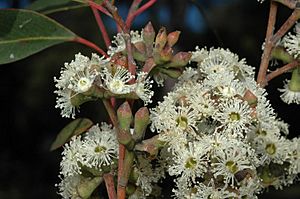Tindal's stringybark facts for kids
Quick facts for kids Tindal's stringybark |
|
|---|---|
 |
|
| Eucalyptus tindaliae in the ANBG | |
| Scientific classification | |
| Genus: |
Eucalyptus
|
| Species: |
tindaliae
|
| Synonyms | |
|
|
The Tindal's stringybark (scientific name: Eucalyptus tindaliae) is a special type of tree. It grows only in the coastal areas of eastern Australia. This tree is known for its rough, stringy bark on its trunk and big branches. It has long, curved leaves, white flowers, and round fruit.
Contents
What Tindal's Stringybark Looks Like
Tindal's stringybark trees usually grow very tall, reaching about 27 to 30 meters (around 90 to 100 feet). They have a special woody swelling at their base called a lignotuber. This helps the tree regrow if it gets damaged.
The bark on the trunk and larger branches is rough and grey, looking like strings. Younger plants and new shoots have shiny green leaves. These leaves are paler underneath and shaped like an egg or a spear. They are about 30 to 95 millimeters long and 14 to 45 millimeters wide.
Adult leaves are green on both sides. They are shaped like a spear or are slightly curved. These leaves are about 60 to 140 millimeters long and 12 to 37 millimeters wide. Each leaf has a stem, called a petiole, which is about 6 to 20 millimeters long.
Flowers and Fruit
The flowers of the Tindal's stringybark are white. They grow in groups of nine to fifteen. These groups are found where the leaves meet the stem, which is called a leaf axil. Each group of flowers grows on a stalk called a peduncle, which is about 5 to 18 millimeters long.
The individual flower buds are oval-shaped. They are about 3 to 7 millimeters long and 3 to 4 millimeters wide. Each bud has a cap, called an operculum, which can be cone-shaped or rounded.
These trees flower at different times depending on where they grow. In the northern parts of Australia, they flower from May to August. In the southern parts, they flower from January to March.
After flowering, the tree produces a woody, round fruit. This fruit is a type of capsule. It is about 3 to 7 millimeters long and 6 to 10 millimeters wide. The parts that open to release seeds, called valves, are at or below the rim of the fruit.
How Tindal's Stringybark Got Its Name
The scientific name Eucalyptus tindaliae was first officially described in 1929. This was done by a scientist named Joseph Maiden in his book about Eucalyptus trees.
The second part of the name, tindaliae, is a special way to honor someone. It honors Anne Grant Tindal (1859–1928). She was part of a farming family from northern New South Wales, Australia.
Where Tindal's Stringybark Grows
Tindal's stringybark trees like to grow in areas with heavy soil. They are found in dense forests close to the coast. You can find them in Australia from the Atherton Tableland down to Coffs Harbour.


